Communication and Negotiation Report: Workplace Scenarios
VerifiedAdded on 2020/02/24
|10
|2989
|40
Report
AI Summary
This report examines communication and negotiation strategies in the workplace, addressing conflict resolution and cultural differences. The first scenario explores a conflict arising from racial and cultural differences, analyzing negotiation processes and strategies for mediators, including the five stages of negotiation: preparation, definition of ground rules, clarification, bargaining, and closure. The second scenario focuses on negotiation styles in the UAE, highlighting the importance of respect, loyalty, and relationships, and contrasting it with individualistic cultures. The report further discusses effective communication methods, including written communication for requesting a raise and the impact of non-verbal communication in a diverse workplace. The report emphasizes the need for understanding cultural nuances and adapting communication styles to foster effective workplace relationships and successful negotiations. The report provides insights into how to build trust, respect cultural norms, and maintain a professional demeanor when conducting business in the UAE.
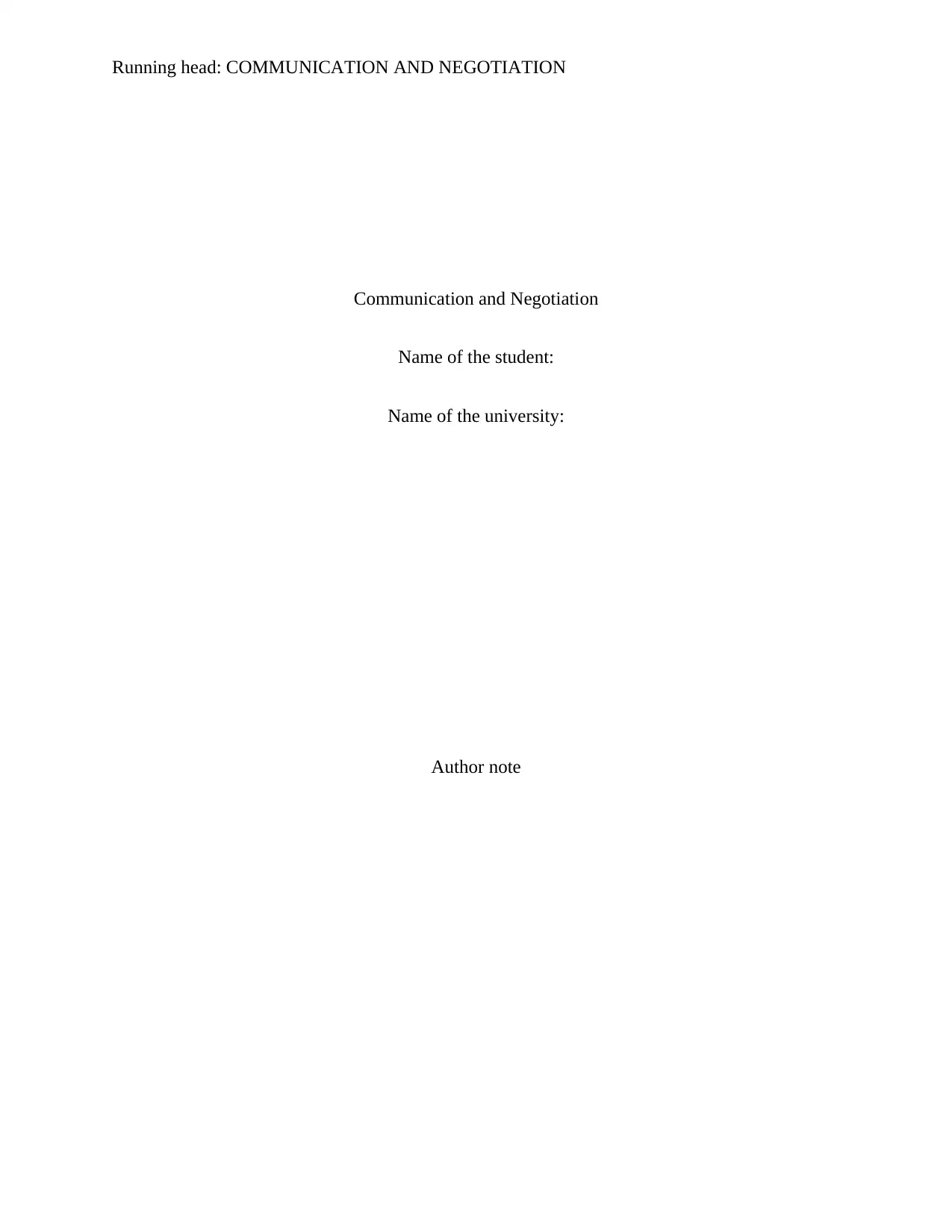
Running head: COMMUNICATION AND NEGOTIATION
Communication and Negotiation
Name of the student:
Name of the university:
Author note
Communication and Negotiation
Name of the student:
Name of the university:
Author note
Paraphrase This Document
Need a fresh take? Get an instant paraphrase of this document with our AI Paraphraser
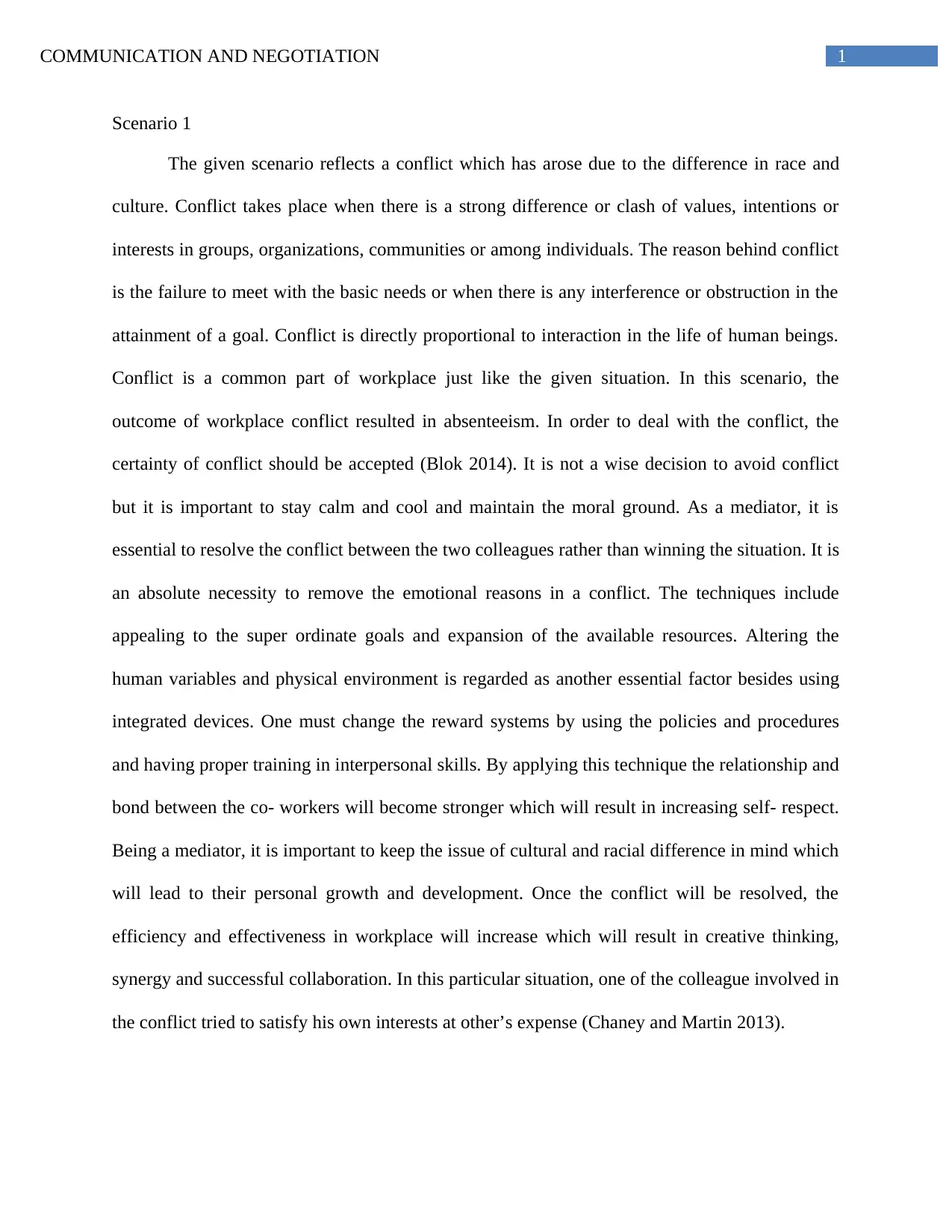
1COMMUNICATION AND NEGOTIATION
Scenario 1
The given scenario reflects a conflict which has arose due to the difference in race and
culture. Conflict takes place when there is a strong difference or clash of values, intentions or
interests in groups, organizations, communities or among individuals. The reason behind conflict
is the failure to meet with the basic needs or when there is any interference or obstruction in the
attainment of a goal. Conflict is directly proportional to interaction in the life of human beings.
Conflict is a common part of workplace just like the given situation. In this scenario, the
outcome of workplace conflict resulted in absenteeism. In order to deal with the conflict, the
certainty of conflict should be accepted (Blok 2014). It is not a wise decision to avoid conflict
but it is important to stay calm and cool and maintain the moral ground. As a mediator, it is
essential to resolve the conflict between the two colleagues rather than winning the situation. It is
an absolute necessity to remove the emotional reasons in a conflict. The techniques include
appealing to the super ordinate goals and expansion of the available resources. Altering the
human variables and physical environment is regarded as another essential factor besides using
integrated devices. One must change the reward systems by using the policies and procedures
and having proper training in interpersonal skills. By applying this technique the relationship and
bond between the co- workers will become stronger which will result in increasing self- respect.
Being a mediator, it is important to keep the issue of cultural and racial difference in mind which
will lead to their personal growth and development. Once the conflict will be resolved, the
efficiency and effectiveness in workplace will increase which will result in creative thinking,
synergy and successful collaboration. In this particular situation, one of the colleague involved in
the conflict tried to satisfy his own interests at other’s expense (Chaney and Martin 2013).
Scenario 1
The given scenario reflects a conflict which has arose due to the difference in race and
culture. Conflict takes place when there is a strong difference or clash of values, intentions or
interests in groups, organizations, communities or among individuals. The reason behind conflict
is the failure to meet with the basic needs or when there is any interference or obstruction in the
attainment of a goal. Conflict is directly proportional to interaction in the life of human beings.
Conflict is a common part of workplace just like the given situation. In this scenario, the
outcome of workplace conflict resulted in absenteeism. In order to deal with the conflict, the
certainty of conflict should be accepted (Blok 2014). It is not a wise decision to avoid conflict
but it is important to stay calm and cool and maintain the moral ground. As a mediator, it is
essential to resolve the conflict between the two colleagues rather than winning the situation. It is
an absolute necessity to remove the emotional reasons in a conflict. The techniques include
appealing to the super ordinate goals and expansion of the available resources. Altering the
human variables and physical environment is regarded as another essential factor besides using
integrated devices. One must change the reward systems by using the policies and procedures
and having proper training in interpersonal skills. By applying this technique the relationship and
bond between the co- workers will become stronger which will result in increasing self- respect.
Being a mediator, it is important to keep the issue of cultural and racial difference in mind which
will lead to their personal growth and development. Once the conflict will be resolved, the
efficiency and effectiveness in workplace will increase which will result in creative thinking,
synergy and successful collaboration. In this particular situation, one of the colleague involved in
the conflict tried to satisfy his own interests at other’s expense (Chaney and Martin 2013).
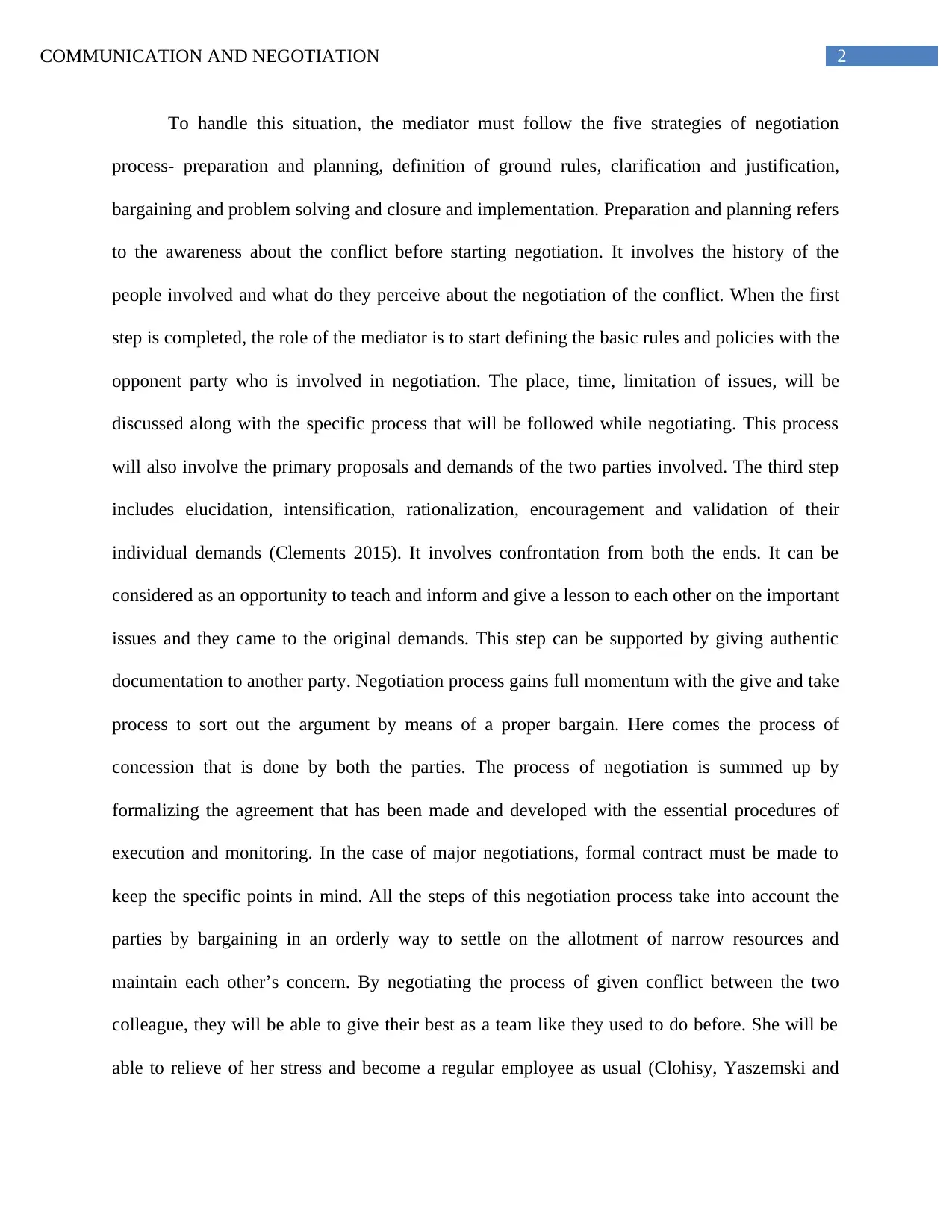
2COMMUNICATION AND NEGOTIATION
To handle this situation, the mediator must follow the five strategies of negotiation
process- preparation and planning, definition of ground rules, clarification and justification,
bargaining and problem solving and closure and implementation. Preparation and planning refers
to the awareness about the conflict before starting negotiation. It involves the history of the
people involved and what do they perceive about the negotiation of the conflict. When the first
step is completed, the role of the mediator is to start defining the basic rules and policies with the
opponent party who is involved in negotiation. The place, time, limitation of issues, will be
discussed along with the specific process that will be followed while negotiating. This process
will also involve the primary proposals and demands of the two parties involved. The third step
includes elucidation, intensification, rationalization, encouragement and validation of their
individual demands (Clements 2015). It involves confrontation from both the ends. It can be
considered as an opportunity to teach and inform and give a lesson to each other on the important
issues and they came to the original demands. This step can be supported by giving authentic
documentation to another party. Negotiation process gains full momentum with the give and take
process to sort out the argument by means of a proper bargain. Here comes the process of
concession that is done by both the parties. The process of negotiation is summed up by
formalizing the agreement that has been made and developed with the essential procedures of
execution and monitoring. In the case of major negotiations, formal contract must be made to
keep the specific points in mind. All the steps of this negotiation process take into account the
parties by bargaining in an orderly way to settle on the allotment of narrow resources and
maintain each other’s concern. By negotiating the process of given conflict between the two
colleague, they will be able to give their best as a team like they used to do before. She will be
able to relieve of her stress and become a regular employee as usual (Clohisy, Yaszemski and
To handle this situation, the mediator must follow the five strategies of negotiation
process- preparation and planning, definition of ground rules, clarification and justification,
bargaining and problem solving and closure and implementation. Preparation and planning refers
to the awareness about the conflict before starting negotiation. It involves the history of the
people involved and what do they perceive about the negotiation of the conflict. When the first
step is completed, the role of the mediator is to start defining the basic rules and policies with the
opponent party who is involved in negotiation. The place, time, limitation of issues, will be
discussed along with the specific process that will be followed while negotiating. This process
will also involve the primary proposals and demands of the two parties involved. The third step
includes elucidation, intensification, rationalization, encouragement and validation of their
individual demands (Clements 2015). It involves confrontation from both the ends. It can be
considered as an opportunity to teach and inform and give a lesson to each other on the important
issues and they came to the original demands. This step can be supported by giving authentic
documentation to another party. Negotiation process gains full momentum with the give and take
process to sort out the argument by means of a proper bargain. Here comes the process of
concession that is done by both the parties. The process of negotiation is summed up by
formalizing the agreement that has been made and developed with the essential procedures of
execution and monitoring. In the case of major negotiations, formal contract must be made to
keep the specific points in mind. All the steps of this negotiation process take into account the
parties by bargaining in an orderly way to settle on the allotment of narrow resources and
maintain each other’s concern. By negotiating the process of given conflict between the two
colleague, they will be able to give their best as a team like they used to do before. She will be
able to relieve of her stress and become a regular employee as usual (Clohisy, Yaszemski and
⊘ This is a preview!⊘
Do you want full access?
Subscribe today to unlock all pages.

Trusted by 1+ million students worldwide
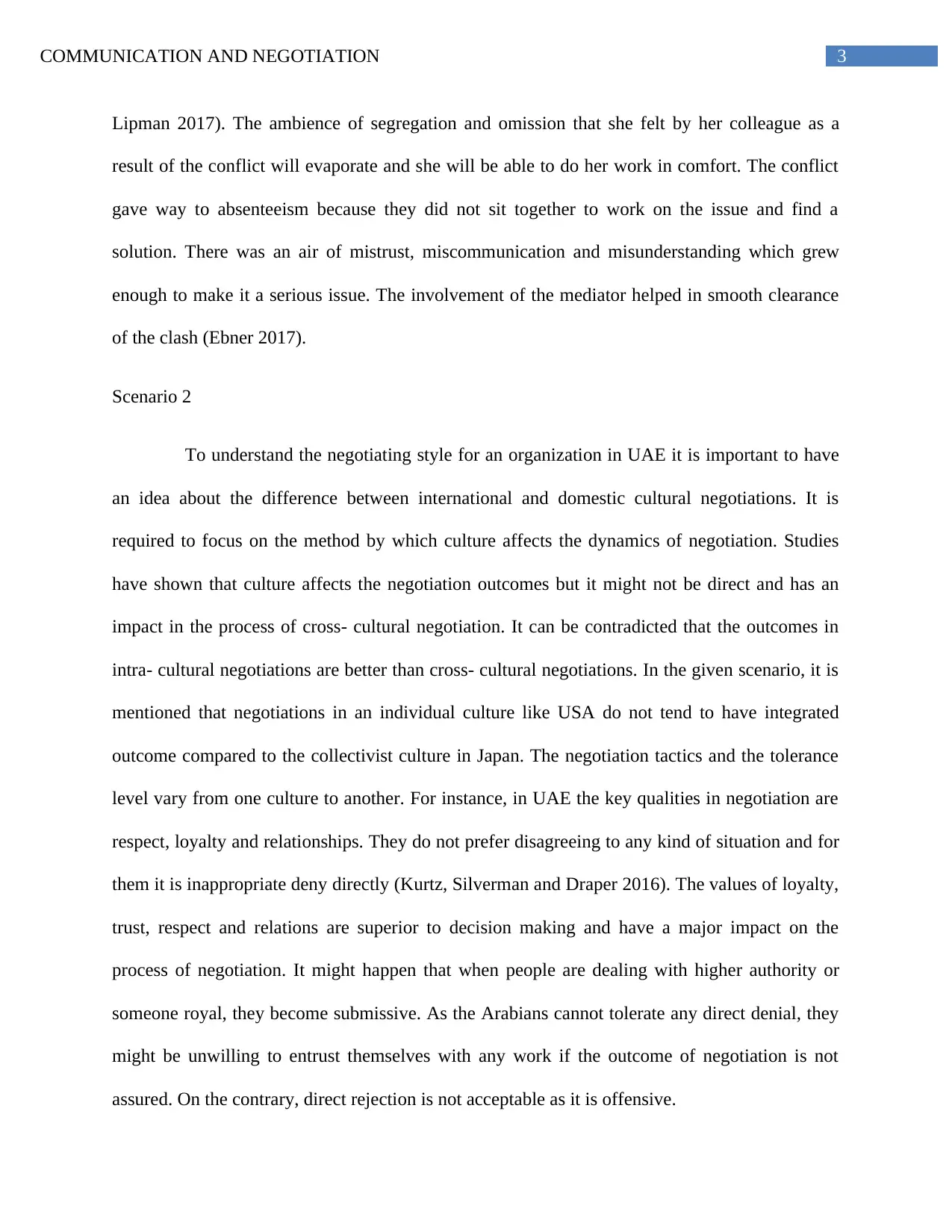
3COMMUNICATION AND NEGOTIATION
Lipman 2017). The ambience of segregation and omission that she felt by her colleague as a
result of the conflict will evaporate and she will be able to do her work in comfort. The conflict
gave way to absenteeism because they did not sit together to work on the issue and find a
solution. There was an air of mistrust, miscommunication and misunderstanding which grew
enough to make it a serious issue. The involvement of the mediator helped in smooth clearance
of the clash (Ebner 2017).
Scenario 2
To understand the negotiating style for an organization in UAE it is important to have
an idea about the difference between international and domestic cultural negotiations. It is
required to focus on the method by which culture affects the dynamics of negotiation. Studies
have shown that culture affects the negotiation outcomes but it might not be direct and has an
impact in the process of cross- cultural negotiation. It can be contradicted that the outcomes in
intra- cultural negotiations are better than cross- cultural negotiations. In the given scenario, it is
mentioned that negotiations in an individual culture like USA do not tend to have integrated
outcome compared to the collectivist culture in Japan. The negotiation tactics and the tolerance
level vary from one culture to another. For instance, in UAE the key qualities in negotiation are
respect, loyalty and relationships. They do not prefer disagreeing to any kind of situation and for
them it is inappropriate deny directly (Kurtz, Silverman and Draper 2016). The values of loyalty,
trust, respect and relations are superior to decision making and have a major impact on the
process of negotiation. It might happen that when people are dealing with higher authority or
someone royal, they become submissive. As the Arabians cannot tolerate any direct denial, they
might be unwilling to entrust themselves with any work if the outcome of negotiation is not
assured. On the contrary, direct rejection is not acceptable as it is offensive.
Lipman 2017). The ambience of segregation and omission that she felt by her colleague as a
result of the conflict will evaporate and she will be able to do her work in comfort. The conflict
gave way to absenteeism because they did not sit together to work on the issue and find a
solution. There was an air of mistrust, miscommunication and misunderstanding which grew
enough to make it a serious issue. The involvement of the mediator helped in smooth clearance
of the clash (Ebner 2017).
Scenario 2
To understand the negotiating style for an organization in UAE it is important to have
an idea about the difference between international and domestic cultural negotiations. It is
required to focus on the method by which culture affects the dynamics of negotiation. Studies
have shown that culture affects the negotiation outcomes but it might not be direct and has an
impact in the process of cross- cultural negotiation. It can be contradicted that the outcomes in
intra- cultural negotiations are better than cross- cultural negotiations. In the given scenario, it is
mentioned that negotiations in an individual culture like USA do not tend to have integrated
outcome compared to the collectivist culture in Japan. The negotiation tactics and the tolerance
level vary from one culture to another. For instance, in UAE the key qualities in negotiation are
respect, loyalty and relationships. They do not prefer disagreeing to any kind of situation and for
them it is inappropriate deny directly (Kurtz, Silverman and Draper 2016). The values of loyalty,
trust, respect and relations are superior to decision making and have a major impact on the
process of negotiation. It might happen that when people are dealing with higher authority or
someone royal, they become submissive. As the Arabians cannot tolerate any direct denial, they
might be unwilling to entrust themselves with any work if the outcome of negotiation is not
assured. On the contrary, direct rejection is not acceptable as it is offensive.
Paraphrase This Document
Need a fresh take? Get an instant paraphrase of this document with our AI Paraphraser
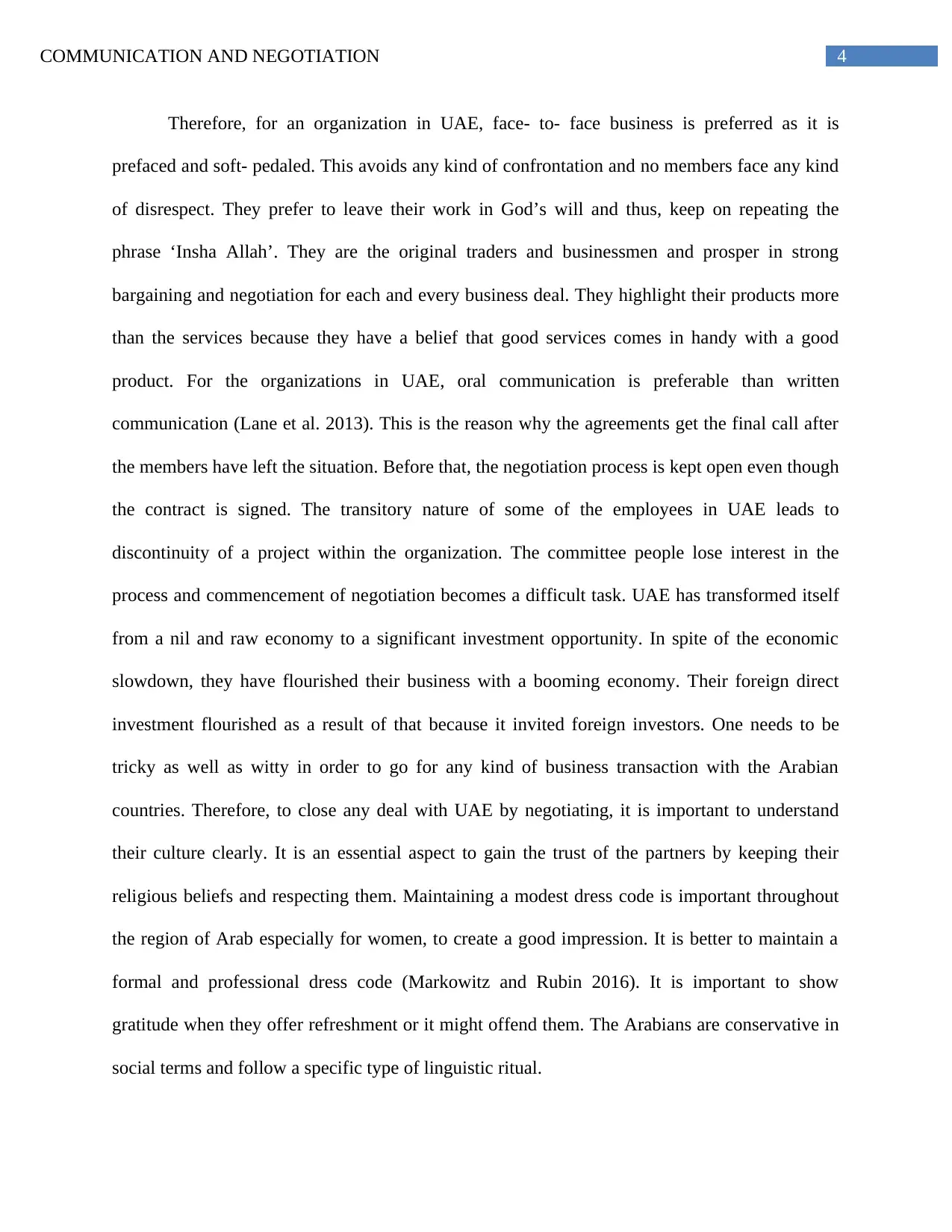
4COMMUNICATION AND NEGOTIATION
Therefore, for an organization in UAE, face- to- face business is preferred as it is
prefaced and soft- pedaled. This avoids any kind of confrontation and no members face any kind
of disrespect. They prefer to leave their work in God’s will and thus, keep on repeating the
phrase ‘Insha Allah’. They are the original traders and businessmen and prosper in strong
bargaining and negotiation for each and every business deal. They highlight their products more
than the services because they have a belief that good services comes in handy with a good
product. For the organizations in UAE, oral communication is preferable than written
communication (Lane et al. 2013). This is the reason why the agreements get the final call after
the members have left the situation. Before that, the negotiation process is kept open even though
the contract is signed. The transitory nature of some of the employees in UAE leads to
discontinuity of a project within the organization. The committee people lose interest in the
process and commencement of negotiation becomes a difficult task. UAE has transformed itself
from a nil and raw economy to a significant investment opportunity. In spite of the economic
slowdown, they have flourished their business with a booming economy. Their foreign direct
investment flourished as a result of that because it invited foreign investors. One needs to be
tricky as well as witty in order to go for any kind of business transaction with the Arabian
countries. Therefore, to close any deal with UAE by negotiating, it is important to understand
their culture clearly. It is an essential aspect to gain the trust of the partners by keeping their
religious beliefs and respecting them. Maintaining a modest dress code is important throughout
the region of Arab especially for women, to create a good impression. It is better to maintain a
formal and professional dress code (Markowitz and Rubin 2016). It is important to show
gratitude when they offer refreshment or it might offend them. The Arabians are conservative in
social terms and follow a specific type of linguistic ritual.
Therefore, for an organization in UAE, face- to- face business is preferred as it is
prefaced and soft- pedaled. This avoids any kind of confrontation and no members face any kind
of disrespect. They prefer to leave their work in God’s will and thus, keep on repeating the
phrase ‘Insha Allah’. They are the original traders and businessmen and prosper in strong
bargaining and negotiation for each and every business deal. They highlight their products more
than the services because they have a belief that good services comes in handy with a good
product. For the organizations in UAE, oral communication is preferable than written
communication (Lane et al. 2013). This is the reason why the agreements get the final call after
the members have left the situation. Before that, the negotiation process is kept open even though
the contract is signed. The transitory nature of some of the employees in UAE leads to
discontinuity of a project within the organization. The committee people lose interest in the
process and commencement of negotiation becomes a difficult task. UAE has transformed itself
from a nil and raw economy to a significant investment opportunity. In spite of the economic
slowdown, they have flourished their business with a booming economy. Their foreign direct
investment flourished as a result of that because it invited foreign investors. One needs to be
tricky as well as witty in order to go for any kind of business transaction with the Arabian
countries. Therefore, to close any deal with UAE by negotiating, it is important to understand
their culture clearly. It is an essential aspect to gain the trust of the partners by keeping their
religious beliefs and respecting them. Maintaining a modest dress code is important throughout
the region of Arab especially for women, to create a good impression. It is better to maintain a
formal and professional dress code (Markowitz and Rubin 2016). It is important to show
gratitude when they offer refreshment or it might offend them. The Arabians are conservative in
social terms and follow a specific type of linguistic ritual.
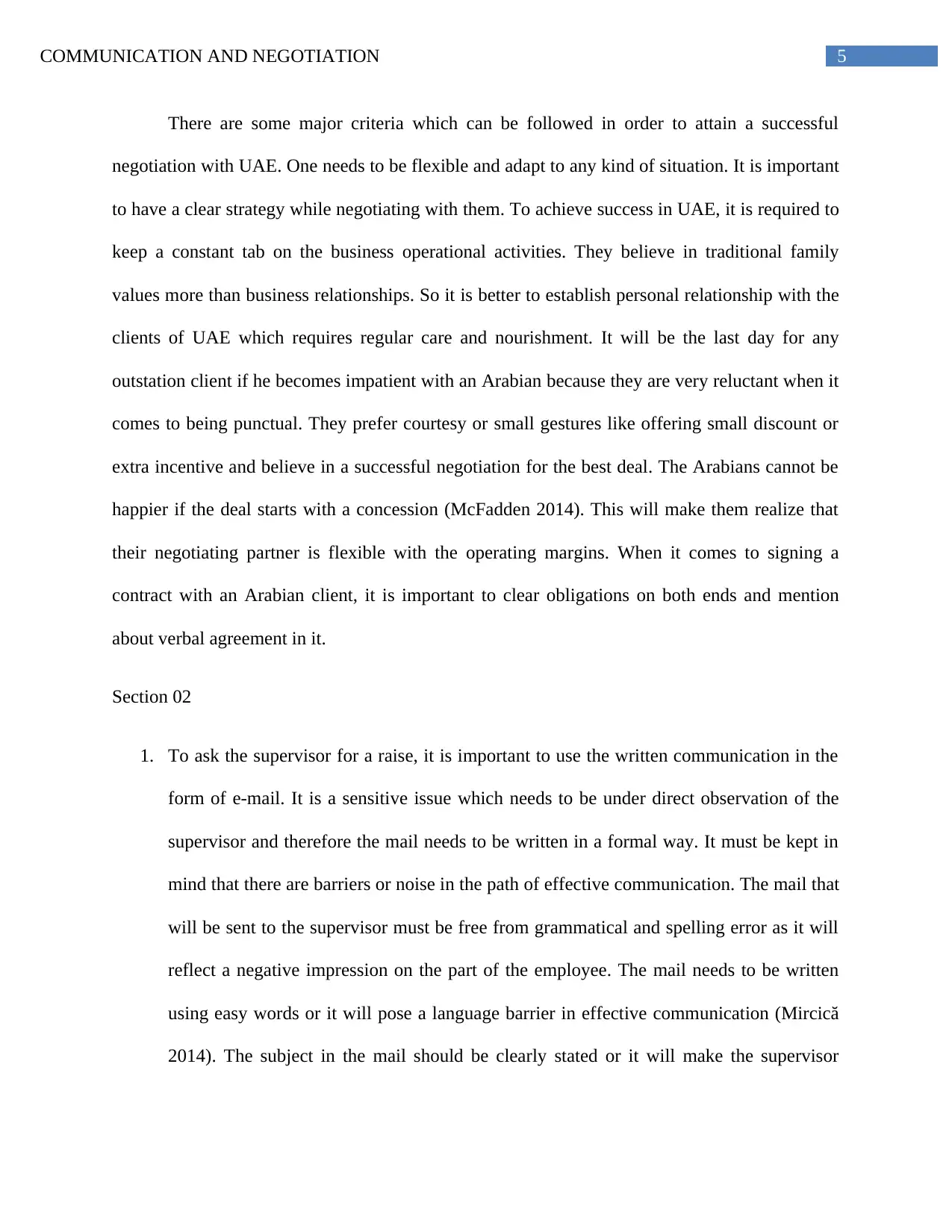
5COMMUNICATION AND NEGOTIATION
There are some major criteria which can be followed in order to attain a successful
negotiation with UAE. One needs to be flexible and adapt to any kind of situation. It is important
to have a clear strategy while negotiating with them. To achieve success in UAE, it is required to
keep a constant tab on the business operational activities. They believe in traditional family
values more than business relationships. So it is better to establish personal relationship with the
clients of UAE which requires regular care and nourishment. It will be the last day for any
outstation client if he becomes impatient with an Arabian because they are very reluctant when it
comes to being punctual. They prefer courtesy or small gestures like offering small discount or
extra incentive and believe in a successful negotiation for the best deal. The Arabians cannot be
happier if the deal starts with a concession (McFadden 2014). This will make them realize that
their negotiating partner is flexible with the operating margins. When it comes to signing a
contract with an Arabian client, it is important to clear obligations on both ends and mention
about verbal agreement in it.
Section 02
1. To ask the supervisor for a raise, it is important to use the written communication in the
form of e-mail. It is a sensitive issue which needs to be under direct observation of the
supervisor and therefore the mail needs to be written in a formal way. It must be kept in
mind that there are barriers or noise in the path of effective communication. The mail that
will be sent to the supervisor must be free from grammatical and spelling error as it will
reflect a negative impression on the part of the employee. The mail needs to be written
using easy words or it will pose a language barrier in effective communication (Mircică
2014). The subject in the mail should be clearly stated or it will make the supervisor
There are some major criteria which can be followed in order to attain a successful
negotiation with UAE. One needs to be flexible and adapt to any kind of situation. It is important
to have a clear strategy while negotiating with them. To achieve success in UAE, it is required to
keep a constant tab on the business operational activities. They believe in traditional family
values more than business relationships. So it is better to establish personal relationship with the
clients of UAE which requires regular care and nourishment. It will be the last day for any
outstation client if he becomes impatient with an Arabian because they are very reluctant when it
comes to being punctual. They prefer courtesy or small gestures like offering small discount or
extra incentive and believe in a successful negotiation for the best deal. The Arabians cannot be
happier if the deal starts with a concession (McFadden 2014). This will make them realize that
their negotiating partner is flexible with the operating margins. When it comes to signing a
contract with an Arabian client, it is important to clear obligations on both ends and mention
about verbal agreement in it.
Section 02
1. To ask the supervisor for a raise, it is important to use the written communication in the
form of e-mail. It is a sensitive issue which needs to be under direct observation of the
supervisor and therefore the mail needs to be written in a formal way. It must be kept in
mind that there are barriers or noise in the path of effective communication. The mail that
will be sent to the supervisor must be free from grammatical and spelling error as it will
reflect a negative impression on the part of the employee. The mail needs to be written
using easy words or it will pose a language barrier in effective communication (Mircică
2014). The subject in the mail should be clearly stated or it will make the supervisor
⊘ This is a preview!⊘
Do you want full access?
Subscribe today to unlock all pages.

Trusted by 1+ million students worldwide
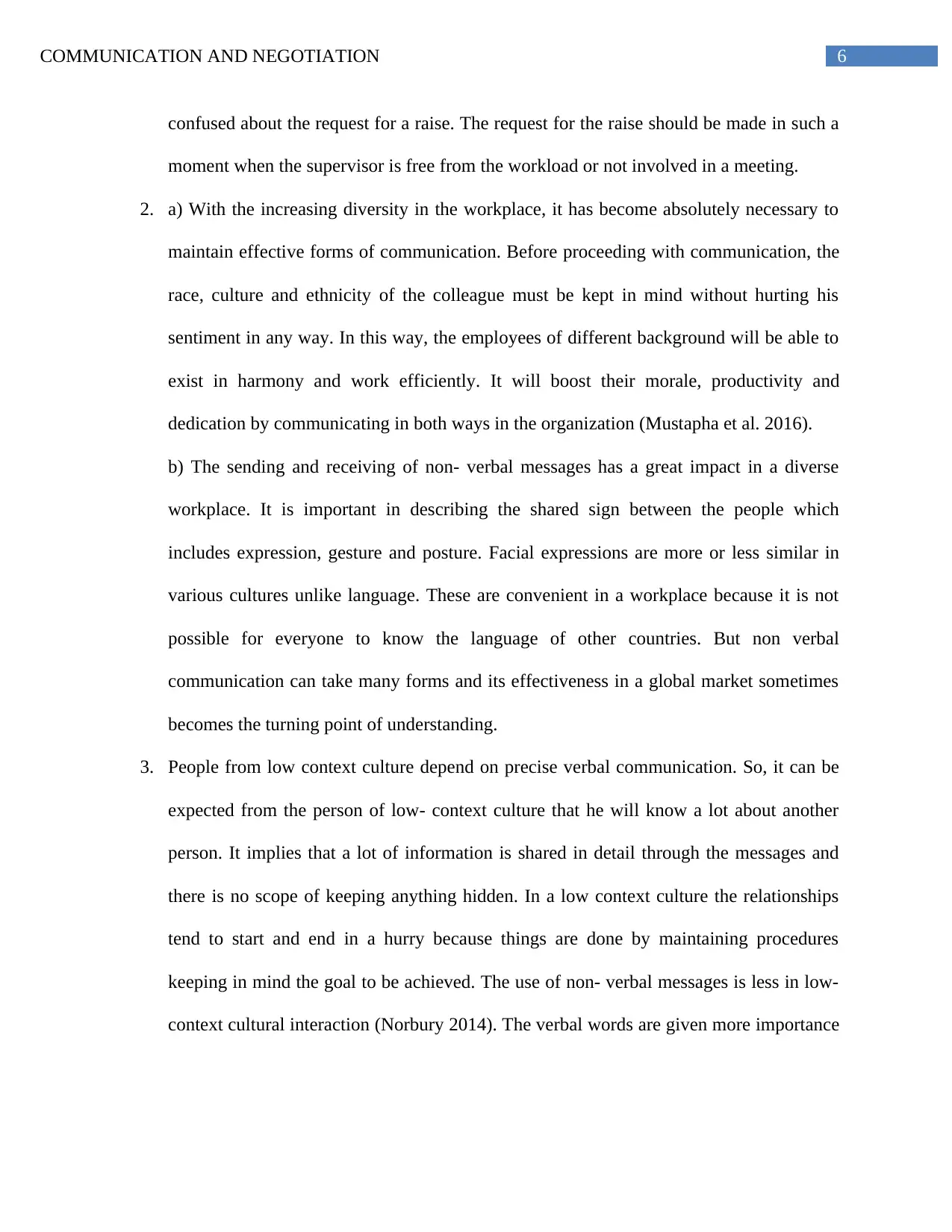
6COMMUNICATION AND NEGOTIATION
confused about the request for a raise. The request for the raise should be made in such a
moment when the supervisor is free from the workload or not involved in a meeting.
2. a) With the increasing diversity in the workplace, it has become absolutely necessary to
maintain effective forms of communication. Before proceeding with communication, the
race, culture and ethnicity of the colleague must be kept in mind without hurting his
sentiment in any way. In this way, the employees of different background will be able to
exist in harmony and work efficiently. It will boost their morale, productivity and
dedication by communicating in both ways in the organization (Mustapha et al. 2016).
b) The sending and receiving of non- verbal messages has a great impact in a diverse
workplace. It is important in describing the shared sign between the people which
includes expression, gesture and posture. Facial expressions are more or less similar in
various cultures unlike language. These are convenient in a workplace because it is not
possible for everyone to know the language of other countries. But non verbal
communication can take many forms and its effectiveness in a global market sometimes
becomes the turning point of understanding.
3. People from low context culture depend on precise verbal communication. So, it can be
expected from the person of low- context culture that he will know a lot about another
person. It implies that a lot of information is shared in detail through the messages and
there is no scope of keeping anything hidden. In a low context culture the relationships
tend to start and end in a hurry because things are done by maintaining procedures
keeping in mind the goal to be achieved. The use of non- verbal messages is less in low-
context cultural interaction (Norbury 2014). The verbal words are given more importance
confused about the request for a raise. The request for the raise should be made in such a
moment when the supervisor is free from the workload or not involved in a meeting.
2. a) With the increasing diversity in the workplace, it has become absolutely necessary to
maintain effective forms of communication. Before proceeding with communication, the
race, culture and ethnicity of the colleague must be kept in mind without hurting his
sentiment in any way. In this way, the employees of different background will be able to
exist in harmony and work efficiently. It will boost their morale, productivity and
dedication by communicating in both ways in the organization (Mustapha et al. 2016).
b) The sending and receiving of non- verbal messages has a great impact in a diverse
workplace. It is important in describing the shared sign between the people which
includes expression, gesture and posture. Facial expressions are more or less similar in
various cultures unlike language. These are convenient in a workplace because it is not
possible for everyone to know the language of other countries. But non verbal
communication can take many forms and its effectiveness in a global market sometimes
becomes the turning point of understanding.
3. People from low context culture depend on precise verbal communication. So, it can be
expected from the person of low- context culture that he will know a lot about another
person. It implies that a lot of information is shared in detail through the messages and
there is no scope of keeping anything hidden. In a low context culture the relationships
tend to start and end in a hurry because things are done by maintaining procedures
keeping in mind the goal to be achieved. The use of non- verbal messages is less in low-
context cultural interaction (Norbury 2014). The verbal words are given more importance
Paraphrase This Document
Need a fresh take? Get an instant paraphrase of this document with our AI Paraphraser
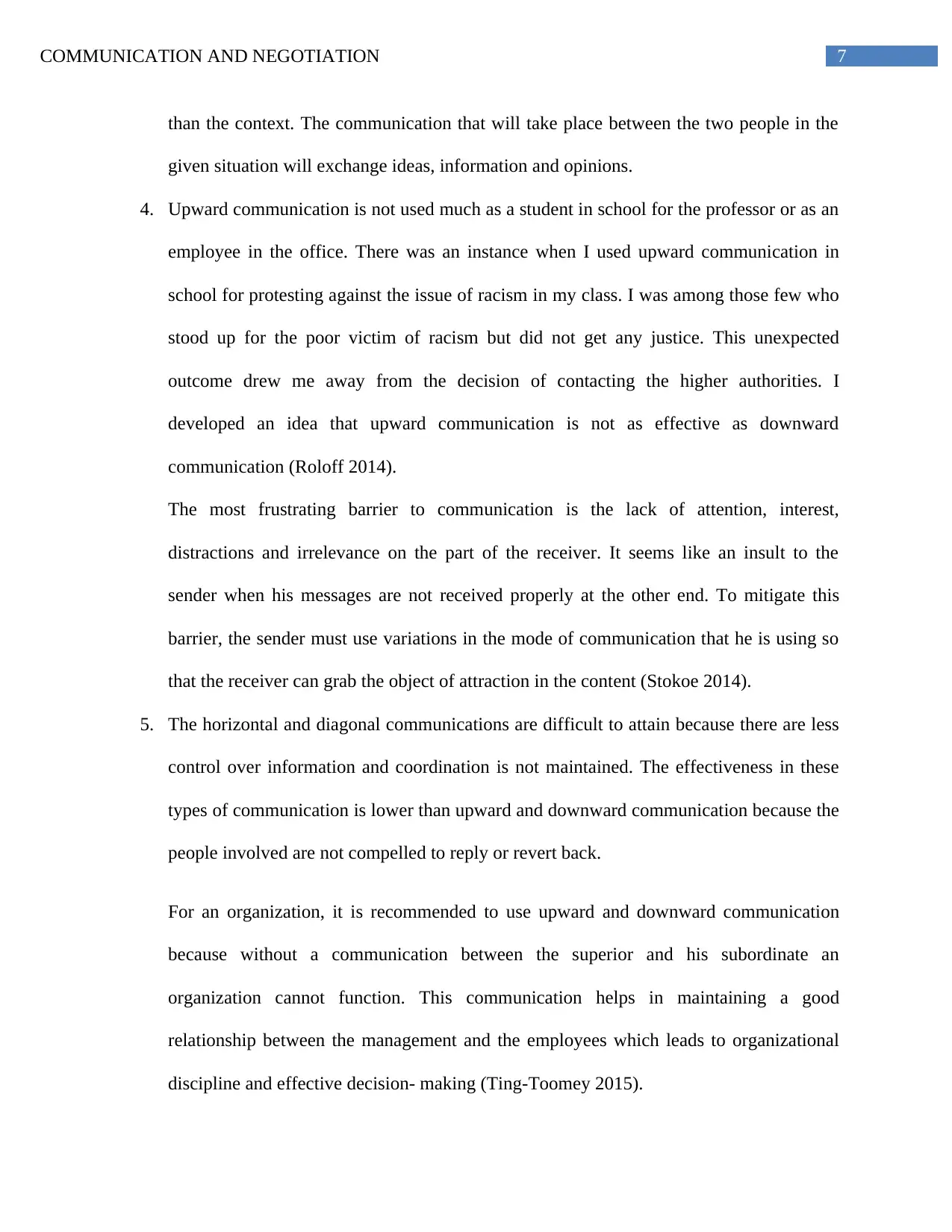
7COMMUNICATION AND NEGOTIATION
than the context. The communication that will take place between the two people in the
given situation will exchange ideas, information and opinions.
4. Upward communication is not used much as a student in school for the professor or as an
employee in the office. There was an instance when I used upward communication in
school for protesting against the issue of racism in my class. I was among those few who
stood up for the poor victim of racism but did not get any justice. This unexpected
outcome drew me away from the decision of contacting the higher authorities. I
developed an idea that upward communication is not as effective as downward
communication (Roloff 2014).
The most frustrating barrier to communication is the lack of attention, interest,
distractions and irrelevance on the part of the receiver. It seems like an insult to the
sender when his messages are not received properly at the other end. To mitigate this
barrier, the sender must use variations in the mode of communication that he is using so
that the receiver can grab the object of attraction in the content (Stokoe 2014).
5. The horizontal and diagonal communications are difficult to attain because there are less
control over information and coordination is not maintained. The effectiveness in these
types of communication is lower than upward and downward communication because the
people involved are not compelled to reply or revert back.
For an organization, it is recommended to use upward and downward communication
because without a communication between the superior and his subordinate an
organization cannot function. This communication helps in maintaining a good
relationship between the management and the employees which leads to organizational
discipline and effective decision- making (Ting‐Toomey 2015).
than the context. The communication that will take place between the two people in the
given situation will exchange ideas, information and opinions.
4. Upward communication is not used much as a student in school for the professor or as an
employee in the office. There was an instance when I used upward communication in
school for protesting against the issue of racism in my class. I was among those few who
stood up for the poor victim of racism but did not get any justice. This unexpected
outcome drew me away from the decision of contacting the higher authorities. I
developed an idea that upward communication is not as effective as downward
communication (Roloff 2014).
The most frustrating barrier to communication is the lack of attention, interest,
distractions and irrelevance on the part of the receiver. It seems like an insult to the
sender when his messages are not received properly at the other end. To mitigate this
barrier, the sender must use variations in the mode of communication that he is using so
that the receiver can grab the object of attraction in the content (Stokoe 2014).
5. The horizontal and diagonal communications are difficult to attain because there are less
control over information and coordination is not maintained. The effectiveness in these
types of communication is lower than upward and downward communication because the
people involved are not compelled to reply or revert back.
For an organization, it is recommended to use upward and downward communication
because without a communication between the superior and his subordinate an
organization cannot function. This communication helps in maintaining a good
relationship between the management and the employees which leads to organizational
discipline and effective decision- making (Ting‐Toomey 2015).
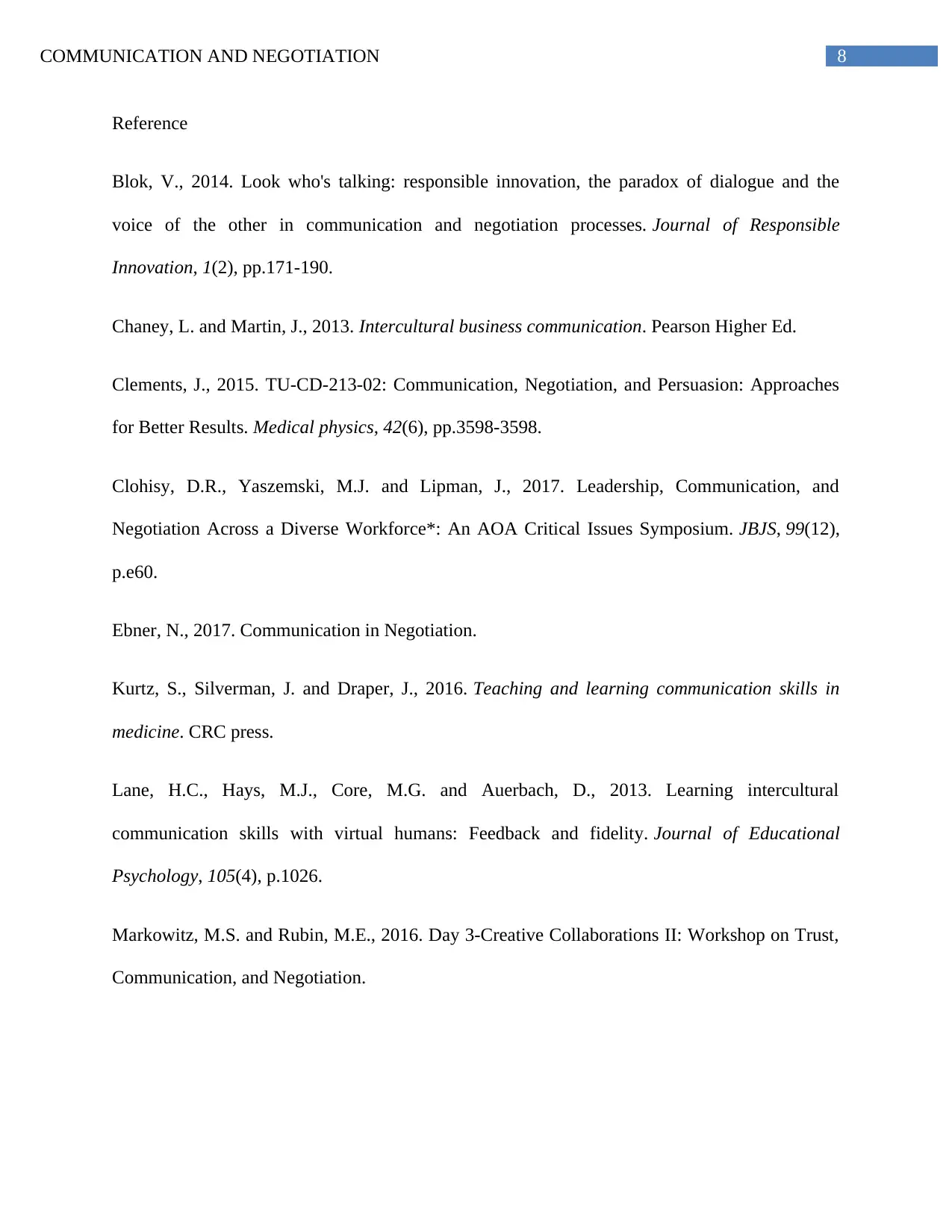
8COMMUNICATION AND NEGOTIATION
Reference
Blok, V., 2014. Look who's talking: responsible innovation, the paradox of dialogue and the
voice of the other in communication and negotiation processes. Journal of Responsible
Innovation, 1(2), pp.171-190.
Chaney, L. and Martin, J., 2013. Intercultural business communication. Pearson Higher Ed.
Clements, J., 2015. TU‐CD‐213‐02: Communication, Negotiation, and Persuasion: Approaches
for Better Results. Medical physics, 42(6), pp.3598-3598.
Clohisy, D.R., Yaszemski, M.J. and Lipman, J., 2017. Leadership, Communication, and
Negotiation Across a Diverse Workforce*: An AOA Critical Issues Symposium. JBJS, 99(12),
p.e60.
Ebner, N., 2017. Communication in Negotiation.
Kurtz, S., Silverman, J. and Draper, J., 2016. Teaching and learning communication skills in
medicine. CRC press.
Lane, H.C., Hays, M.J., Core, M.G. and Auerbach, D., 2013. Learning intercultural
communication skills with virtual humans: Feedback and fidelity. Journal of Educational
Psychology, 105(4), p.1026.
Markowitz, M.S. and Rubin, M.E., 2016. Day 3-Creative Collaborations II: Workshop on Trust,
Communication, and Negotiation.
Reference
Blok, V., 2014. Look who's talking: responsible innovation, the paradox of dialogue and the
voice of the other in communication and negotiation processes. Journal of Responsible
Innovation, 1(2), pp.171-190.
Chaney, L. and Martin, J., 2013. Intercultural business communication. Pearson Higher Ed.
Clements, J., 2015. TU‐CD‐213‐02: Communication, Negotiation, and Persuasion: Approaches
for Better Results. Medical physics, 42(6), pp.3598-3598.
Clohisy, D.R., Yaszemski, M.J. and Lipman, J., 2017. Leadership, Communication, and
Negotiation Across a Diverse Workforce*: An AOA Critical Issues Symposium. JBJS, 99(12),
p.e60.
Ebner, N., 2017. Communication in Negotiation.
Kurtz, S., Silverman, J. and Draper, J., 2016. Teaching and learning communication skills in
medicine. CRC press.
Lane, H.C., Hays, M.J., Core, M.G. and Auerbach, D., 2013. Learning intercultural
communication skills with virtual humans: Feedback and fidelity. Journal of Educational
Psychology, 105(4), p.1026.
Markowitz, M.S. and Rubin, M.E., 2016. Day 3-Creative Collaborations II: Workshop on Trust,
Communication, and Negotiation.
⊘ This is a preview!⊘
Do you want full access?
Subscribe today to unlock all pages.

Trusted by 1+ million students worldwide
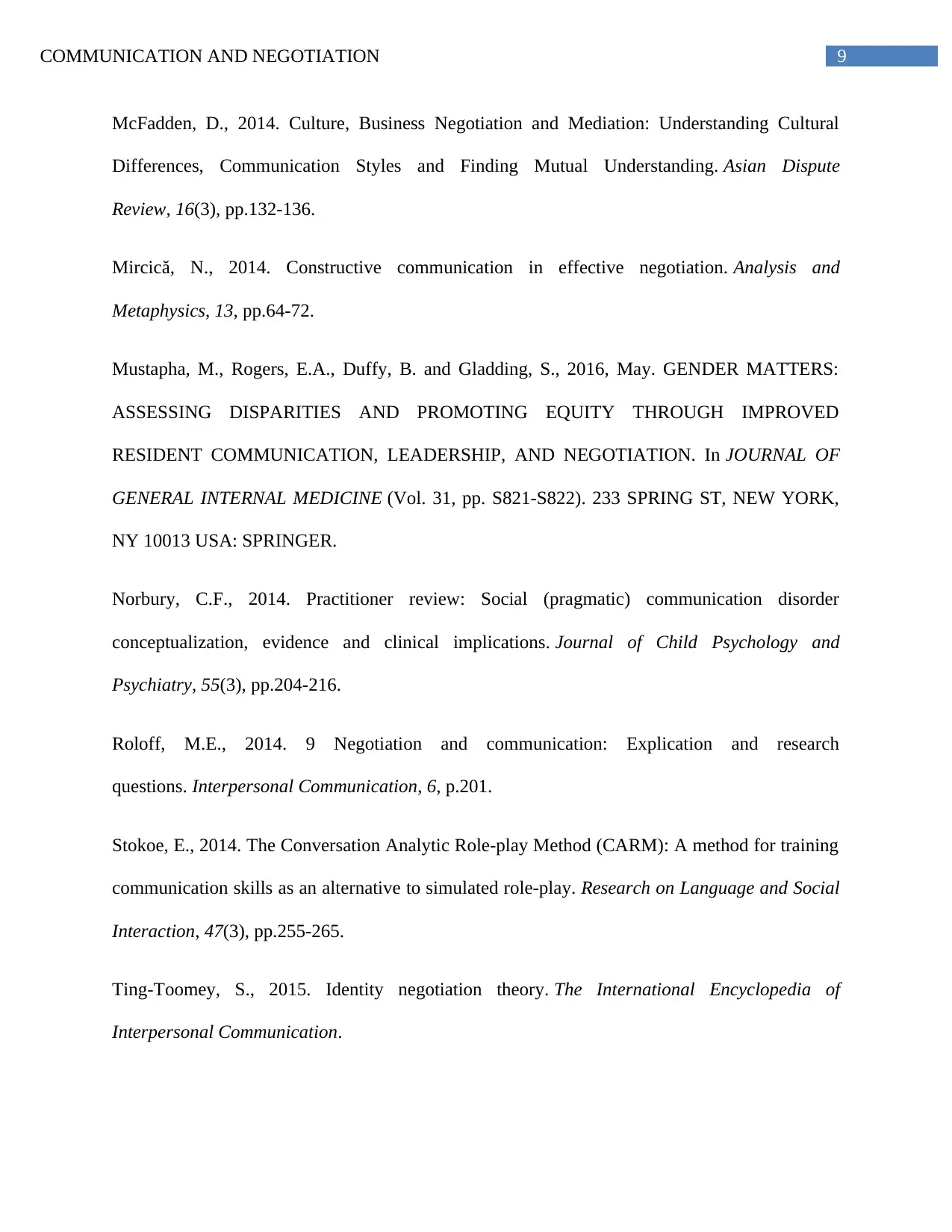
9COMMUNICATION AND NEGOTIATION
McFadden, D., 2014. Culture, Business Negotiation and Mediation: Understanding Cultural
Differences, Communication Styles and Finding Mutual Understanding. Asian Dispute
Review, 16(3), pp.132-136.
Mircică, N., 2014. Constructive communication in effective negotiation. Analysis and
Metaphysics, 13, pp.64-72.
Mustapha, M., Rogers, E.A., Duffy, B. and Gladding, S., 2016, May. GENDER MATTERS:
ASSESSING DISPARITIES AND PROMOTING EQUITY THROUGH IMPROVED
RESIDENT COMMUNICATION, LEADERSHIP, AND NEGOTIATION. In JOURNAL OF
GENERAL INTERNAL MEDICINE (Vol. 31, pp. S821-S822). 233 SPRING ST, NEW YORK,
NY 10013 USA: SPRINGER.
Norbury, C.F., 2014. Practitioner review: Social (pragmatic) communication disorder
conceptualization, evidence and clinical implications. Journal of Child Psychology and
Psychiatry, 55(3), pp.204-216.
Roloff, M.E., 2014. 9 Negotiation and communication: Explication and research
questions. Interpersonal Communication, 6, p.201.
Stokoe, E., 2014. The Conversation Analytic Role-play Method (CARM): A method for training
communication skills as an alternative to simulated role-play. Research on Language and Social
Interaction, 47(3), pp.255-265.
Ting‐Toomey, S., 2015. Identity negotiation theory. The International Encyclopedia of
Interpersonal Communication.
McFadden, D., 2014. Culture, Business Negotiation and Mediation: Understanding Cultural
Differences, Communication Styles and Finding Mutual Understanding. Asian Dispute
Review, 16(3), pp.132-136.
Mircică, N., 2014. Constructive communication in effective negotiation. Analysis and
Metaphysics, 13, pp.64-72.
Mustapha, M., Rogers, E.A., Duffy, B. and Gladding, S., 2016, May. GENDER MATTERS:
ASSESSING DISPARITIES AND PROMOTING EQUITY THROUGH IMPROVED
RESIDENT COMMUNICATION, LEADERSHIP, AND NEGOTIATION. In JOURNAL OF
GENERAL INTERNAL MEDICINE (Vol. 31, pp. S821-S822). 233 SPRING ST, NEW YORK,
NY 10013 USA: SPRINGER.
Norbury, C.F., 2014. Practitioner review: Social (pragmatic) communication disorder
conceptualization, evidence and clinical implications. Journal of Child Psychology and
Psychiatry, 55(3), pp.204-216.
Roloff, M.E., 2014. 9 Negotiation and communication: Explication and research
questions. Interpersonal Communication, 6, p.201.
Stokoe, E., 2014. The Conversation Analytic Role-play Method (CARM): A method for training
communication skills as an alternative to simulated role-play. Research on Language and Social
Interaction, 47(3), pp.255-265.
Ting‐Toomey, S., 2015. Identity negotiation theory. The International Encyclopedia of
Interpersonal Communication.
1 out of 10
Related Documents
Your All-in-One AI-Powered Toolkit for Academic Success.
+13062052269
info@desklib.com
Available 24*7 on WhatsApp / Email
![[object Object]](/_next/static/media/star-bottom.7253800d.svg)
Unlock your academic potential
Copyright © 2020–2025 A2Z Services. All Rights Reserved. Developed and managed by ZUCOL.





